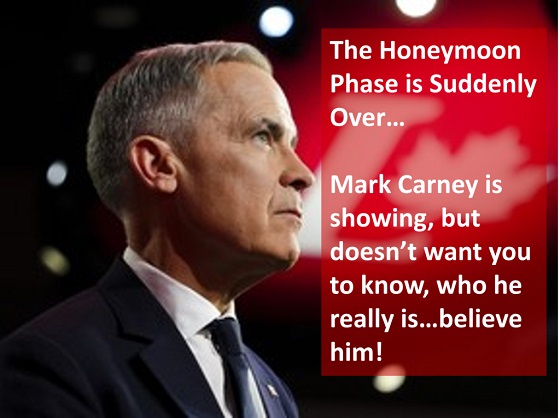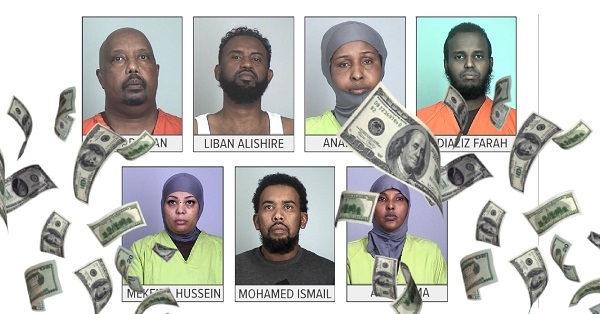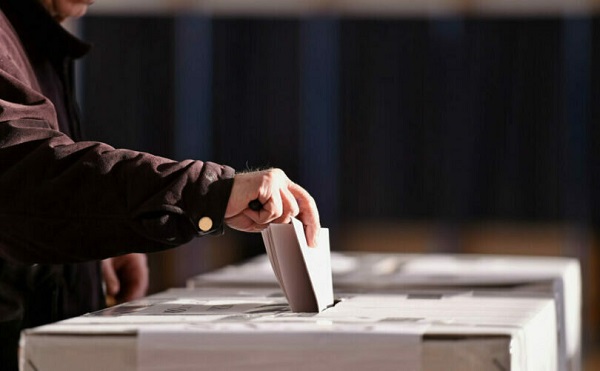Business
Mark Carney’s Misleading Actions and Non-Disclosure Should Disqualify Him as Canada’s Next Truly “Elected” Prime Minister – Jim Warren

From EnergyNow.Ca
By Jim Warren
If Mark Carney simply told the truth, he wouldn’t have to remember if what he says in Quebec matches what he says in Western Canada.
When speaking in Kelowna on February 12, Mark Carney left the impression he’d been converted from environmental zealot to missionary for an Energy East pipeline.
Carney said he would “use all of the powers of the federal government, including the emergency powers of the federal government, to accelerate the major projects that we need in order to build this economy and take on the Americans.”
Five days later Carney told CBC those emergency powers wouldn’t apply to Quebec. The government of Quebec would have veto power over any pipeline to the east coast. To clear up any possible confusion he repeated his pipeline veto pledge to Quebec at the French debate for the Liberal Leadership.
Apparently tough measures like the “peace, order and good government” clause in the Constitution and the Emergencies Act can be used by Liberals to arrest and seize the bank accounts of truckers who honk horns and cause traffic jams in Ottawa. But they can’t be used to build pipelines across Quebec even if it will reduce the impact of US tariffs on Canada’s economy. Like any good Liberal, Carney knows the interests of Maritimers and the West are of little consequence when his party needs to boost its support in Quebec.
Ironically, the second national poll in the past few months shows a majority of Quebecers support the construction of an East/West pipeline through their province. It is the Central Canadian political elite based in the major cities of Ontario and Quebec and excessively zealous environmental activists who oppose pipelines. And the Liberals are, of course, the party which represents that environmentally sanctimonious elite.
You read it here first.
On January 28, EnergyNow ran a column with the headline: Trump’s Wake-up Call to Canada, Politicians & Activists… The column outlined how the “peace, order and good government’” clause in the Constitution and/or the Emergencies Act could be employed to override regulatory barriers and court injunctions to ensure new pipelines to tidewater are built. The column says the first step in that process will be booting the Liberals from office. That condition still applies, given that Carney’s one-time mention of using “emergency powers” in support of a West to East pipeline turned out to be just one more Liberal lie to Western Canada.
Pierre Poilievre has aptly pegged Mark Carney as a hypocrite whose corporate interests and behavior are in substantial conflict with his environmental virtue signaling. At a House of Commons committee hearing in 2021, Poilievre spanked Carney for supporting the cancellation of the Energy East pipeline, while Brookfield Asset Management, the company he chaired, had bought pipelines in Brazil and the United Arab Emirates.
Poilievre admonished Carney, “You make billions of dollars off foreign pipelines and you shut them down here at home, putting our people out of work.”
More recently Carney misled Canadians about the role he played in moving Brookfield’s head office from Canada to the US. Carney claimed he had absolutely nothing to do with the move despite the fact he was company chairman at the time.
No less egregious is the fact Carney has used a loophole in federal legislation to avoid the financial disclosure rules for cabinet ministers including the prime minister. The disclosure rules help Parliament determine when ministers are involved in conflicts of interest. Carney will soon be crowned prime minister by the Liberals and will technically be exempt from the rule.
Carney is technically exempt because he’s never been elected as an MP. He will be able to avoid making his financial disclosure until 60 days after he is appointed prime minster. This means there is a good chance Carney’s financial information won’t be available well into the run up to a possible spring election.
Poilievre rang the alarm regarding the loophole and plans to introduce legislation as soon as Parliament reopens to fix the problem. He pointed out that there was nothing preventing Carney from being transparent and voluntarily providing the necessary information to Canadians prior to the Liberal leadership vote.
Poilevre was being too kind. A lack of integrity is what’s holding Carney back.
Carney is on record as a firm believer in carbon taxes. In the book he published in 2023 he wrote, “Meaningful carbon prices are the cornerstone of any effective [environmental] policy framework.”
Now, in support of his campaign to become prime minister, Carney promises to get rid of Canada’s unpopular carbon tax. The claim is clearly deceptive. He intends to replace the current tax on consumers with an upstream tax on oil producers and industry. Carney must think Canadians are too dumb to realize the increased upstream tax burden will be passed on to consumers in the form of higher prices for virtually everything they purchase.
When Carney is pressed to explain his carbon tax 2.0, he mumbles his way through an incomprehensible word salad worthy of Kamala Harris.
Also like Harris, Carney avoids campaign events where non-supporters might show up or media appearances and interviews where he might be asked a tough question. His appearance on US late night talk shows hosted by uber-liberals like Jon Stewart are unlikely to generate hard ball questions—the hosts are ignorant about Canadian politics and wouldn’t have a clue about what to ask.
I think Carney knows how bad the Kamala campaign tactics look. He was clearly taken aback by an incident at a campaign event in Regina. A member of the Liberal party who was somehow identified as a closet Conservative was accosted by two security agents and police who ejected him from the meeting. The guy had done nothing untoward—he hadn’t so much as raised his voice. It seems Mark Carney is very precious and must be protected from the public– including Liberal party members who are potentially dangerous because they supported another party in the past.
Where Carney really stands on environmental issues
Mark Carney didn’t just drink the climate alarmist Kool-Aid, he helped make it and wants to serve it to you.
“He’s the father of net-zero on a global basis,” according to Catherine Swift, President of the Canadian Coalition of Concerned Manufacturers and Businesses of Canada.
Carney has been a steadfast supporter of the environmental dogma underlying the Liberal assault on the fortunes of the oil and gas industries including the legislation preventing new pipelines. For years now, he’s been working on the inside of international organizations dedicated to climate change mitigation and greenhouse gas (GHG) emissions reduction.
In December 2019, he was appointed as the very first UN Special Envoy for Climate Action and Finance.
Prior to, during and after his time at the UN Carney has found time to hobnob with the billionaires and national leaders who presumably constitute the global elite. He’s been a regular at the annual World Economic Forum conferences in Davos, Switzerland.
As a member of the forum’s Foundation Board he is a duly qualified member of the modern day Illuminati. He associates with the international bankers who presume to know what’s best for the little people. His promotion of the radical green agenda dovetails nicely with the environmental virtue signaling of the world’s rich and powerful at Davos. They are dedicated to conquering global warming no matter what it costs the rest of us.
At the COP26 conference in 2021 Carney proudly proclaimed he was part of the same social movement as Greta Thunberg. Carney praised Thunberg as the “catalyst” who inspired the youth wing of the environmental movement. I haven’t heard if he’s gone off Greta and her wing of the movement now that she has announced her support for Hamas.
Don Braid recently wrote an insightful column in the Calgary Herald where he proposes that Carney is too deeply embedded in environmental activism and too publicly committed to climate change mitigation and the anti-oil agenda to run away from it when he becomes prime minister. Braid reports what Carney had to say about the environment and the need to abandon natural gas and petroleum in the 600 page door-stopper book he published in 2021, Value(s): Building a Better World for All.
In 2021, Carney was deluded enough to imagine the world’s virtuous emissions cutters would prevent the planet’s average temperature in 2050 from being any higher than 1.5O above what it was in the middle of the 19th century.
Not even serious climate change alarmists like Gwynne Dyer believe that’s remotely possible. The goals of climate zealots like Carney include fanciful, overly ambitious emissions reduction targets. They want change to happen too fast to be affordable for virtually everyone except the sorts of people who hang out at Davos.
In his book, Carney identifies what he believes should happen to the fossil fuel industries. His goals don’t bode well for the future of Canada’s petroleum and gas sectors and can’t help but harm the country’s economy.
Carney writes, “To meet the 1.5o C target, more than 80 per cent of current fossil fuel reserves (including three-quarters of coal, half of gas, one-third of oil)” will need to “stay in the ground, stranding these assets.”
Steven Guilbeault, Canada’s most infamous and politically dangerous environmental extremist backed Carney in the Liberal leadership contest. Guilbeault’s support is in recognition of Carney’s radical record on environmental issues including climate change mitigation.
Nothing to say about Liberal corruption
One of the most disturbing omissions from Carney’s political platform and media coverage of his campaign is any mention of plans for dealing with runaway Liberal cronyism and corruption.
He hasn’t promised to open the books and jail the crooks. He hasn’t promised to release the unredacted evidence of Green Slush Fund corruption. He hasn’t promised to release that evidence and turn it over to Parliament and the RCMP. He hasn’t announced plans for a thorough forensic accounting of Liberal backroom deals. And he hasn’t promised investigations into sweetheart contracts and looting in cases like the ArriveCAN scam.
He can’t do any of the above because it would implicate a number of Liberal insiders and he needed them to support him in the leadership contest. And how will he be able to work with the government caucus if he suggests he wants to get tough with the hogs at the trough? Given that he won’t release his financial information, it could be he doesn’t want to limit his own access to the gravy train.
In the final analysis, you’d have to say Mark Carney is a committed environmental zealot except when it interferes with his business interests or political ambitions.
He appears comfortable giving preference to the environmental extremism of the Davos set over the harm overly zealous climate change policies do to the livelihoods of ordinary Canadians and the country’s economy.
He appears comfortable with hypocrisy and misleading Canadians which clearly qualifies him to lead the Liberal party, but makes for a bad prime minister.
Business
Feds pull the plug on small business grants to Minnesota after massive fraud reports

The Small Business Administration is moving to freeze grant money flowing into Minnesota after explosive allegations of large-scale fraud tied to state oversight failures, with SBA Administrator Kelly Loeffler signaling an immediate crackdown following recent independent reporting.
In a series of comments shared publicly by conservative commentator Benny Johnson, Loeffler said the agency is “cutting off and clawing back” SBA grants to the state while investigators dig deeper into what she described as a rapidly expanding fraud network.
Johnson wrote that Loeffler told him she was “disgusted and sickened” after reviewing footage from YouTuber Nick Shirley, whose on-the-ground reporting in Minnesota highlighted what he said were sham daycare and learning centers collecting millions in public funds despite showing little or no sign of legitimate operations.
According to Johnson, Loeffler blamed the situation on Democrat Gov. Tim Walz, accusing his administration of refusing to enforce basic rules governing small businesses and allowing fraud to flourish unchecked.
Johnson said Loeffler told him SBA investigators were able to identify roughly half a billion dollars in suspected fraud within days of focusing on Minnesota, calling the operation an “industrial-scale crime ring” that ripped off American taxpayers.
“Pending further review, SBA is freezing all grant funding to the state in order to stop the rampant waste of taxpayer dollars and uncover the full depth of fraud,” Loeffler said, according to Johnson’s account, adding that the total scope of the scheme remains unknown and could reach into the billions.
The controversy gained national traction after Shirley posted video of himself visiting multiple facilities, including a South Minneapolis site known as the Quality Learning Center, which he reported was approved for federal aid for up to 99 children but appeared inactive during normal business hours.
The center’s sign, Shirley noted, even misspelled the word “learning” as “learing.”
In the footage, a woman inside the building is heard shouting “Don’t open up,” falsely claiming Shirley and his colleague were Immigration and Customs Enforcement agents.
After the video circulated, Rep. Tom Emmer, a Republican, publicly demanded answers from Walz, questioning how such facilities were approved for millions in taxpayer funding.
Shirley’s reporting followed earlier investigations, including a November report by City Journal alleging that members of Minnesota’s Somali community had sent millions of dollars in stolen taxpayer funds overseas, with some of that money reportedly ending up in the hands of Al-Shabaab, a U.S.-designated terrorist organization.
While Walz’s administration has insisted it takes fraud seriously, the SBA’s decision to halt grant funding marks one of the most aggressive federal responses yet, underscoring how rapidly a local scandal has escalated into a national reckoning over oversight, enforcement, and accountability in Minnesota.
Business
Stripped and shipped: Patel pushes denaturalization, deportation in Minnesota fraud

FBI Director Kash Patel issued a blunt warning over the weekend as federal investigators continue unraveling a sprawling fraud operation centered in Minnesota, saying the hundreds of millions already uncovered represent “just the tip of a very large iceberg.”
In a lengthy statement posted to social media, Patel said the Federal Bureau of Investigation had quietly surged agents and investigative resources into the state well before the scandal gained traction online. That effort, he said, led to the takedown of an estimated $250 million fraud scheme that stole federal food aid intended for vulnerable children during the COVID pandemic.
According to Patel, the investigation exposed a network of sham vendors, shell companies, and large-scale money laundering operations tied to the Feeding Our Future case. Defendants named by the FBI include Abdiwahab Ahmed Mohamud, Ahmed Ali, Hussein Farah, Abdullahe Nur Jesow, Asha Farhan Hassan, Ousman Camara, and Abdirashid Bixi Dool, each charged with offenses ranging from wire fraud to conspiracy and money laundering.
Patel also said Abdimajid Mohamed Nur and others were charged in a separate attempt to bribe a juror with $120,000 in cash. He noted that several related cases have already resulted in guilty pleas, prison sentences of up to 10 years, and nearly $48 million in restitution orders.
Despite those outcomes, Patel warned the case is far from finished.
“The FBI believes this is just the tip of a very large iceberg,” he said, adding that investigators will continue following the money and that the probe remains ongoing. Patel further confirmed that many of those convicted are being referred to immigration authorities for possible denaturalization and deportation proceedings where legally applicable.
The renewed focus follows a viral video circulated by independent journalist Nick Shirley, which appeared to show multiple childcare and learning centers operating as empty or nonfunctional storefronts. The footage sparked immediate backlash from Republicans, including Vice President JD Vance.
House Majority Whip Tom Emmer accused Minnesota Gov. Tim Walz of sitting idle while massive sums were stolen from taxpayers. Walz addressed the allegations during a November press conference, before the full scope of the fraud became public, saying the scandal “undermines trust in government” and threatens programs meant to help vulnerable residents.
“If you’re committing fraud, no matter where you come from or what you believe, you are going to go to jail,” Walz said at the time.
Authorities say the alleged schemes date back to at least 2015, beginning with overbilling Minnesota’s Child Care Assistance Program and later expanding into Medicaid-funded disability and housing programs. One such housing initiative, aimed at helping seniors and disabled residents secure stable housing, was shut down earlier this year after officials cited what they described as large-scale fraud.
The fallout has already reached the federal level. Last month, President Trump announced the suspension of Temporary Protected Status for Somali nationals, arguing that Minnesota had become a hub for organized welfare fraud and money laundering activity.
-

 Digital ID1 day ago
Digital ID1 day agoCanadian government launches trial version of digital ID for certain licenses, permits
-

 Alberta1 day ago
Alberta1 day agoAlberta Next Panel calls to reform how Canada works
-

 Agriculture1 day ago
Agriculture1 day agoEnd Supply Management—For the Sake of Canadian Consumers
-

 International1 day ago
International1 day agoGeorgia county admits illegally certifying 315k ballots in 2020 presidential election
-

 Business1 day ago
Business1 day agoThe “Disruptor-in-Chief” places Canada in the crosshairs
-

 Artificial Intelligence1 day ago
Artificial Intelligence1 day agoUK Police Pilot AI System to Track “Suspicious” Driver Journeys
-

 Energy1 day ago
Energy1 day ago‘The electric story is over’
-

 International1 day ago
International1 day agoWorld-leading biochemist debunks evolutionary theory






